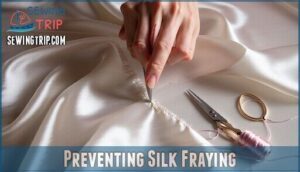This site is supported by our readers. We may earn a commission, at no cost to you, if you purchase through links.
 Yes, silk frays, and it does so easily because of its delicate fibers and loose weave.
Yes, silk frays, and it does so easily because of its delicate fibers and loose weave.
If you’ve ever handled raw silk or chiffon, you know those edges can unravel faster than you’d like.
Factors like the type of silk, how it’s cut, and how it’s handled all play a role.
To prevent fraying, you can use pinking shears, apply fabric glue, or sew the edges with a serger or zig-zag stitch.
Finishing techniques like French seams or binding also work wonders.
Choosing sturdier silk, like dupioni, helps too.
There’s more to explore for keeping your silk looking its best!
Table Of Contents
Key Takeaways
- Silk frays easily due to its delicate fibers and smooth surface, so you’ll need to handle it gently and finish edges properly.
- Use tools like pinking shears, fabric glue, or sewing techniques like French seams or serging to prevent fraying effectively.
- Lightweight silks like chiffon unravel faster, while tighter weaves and sturdier types, such as dupioni, resist fraying better.
- Proper care, including handwashing with mild detergent, air drying flat, and storing with acid-free tissue, helps maintain silk’s longevity.
Silk Fraying Explained
You’ll notice your silk fabric unravels at the edges because its lightweight, slippery fibers easily separate from the main weave when disturbed.
This fraying occurs more rapidly in silk than other fabrics due to its natural structure of delicate protein fibers that can loosen and break apart when subjected to improper handling or harsh cleaning methods, which leads to fraying.
Causes of Silk Fraying
Silk fraying occurs due to several key factors related to the fabric’s natural properties.
The delicate fiber structure of silk makes it susceptible to unraveling, especially when paired with a loose weave density. Thread slippage happens easily because of silk’s smooth surface.
Your handling impact matters too—rough treatment accelerates silk edge fraying. Chemical exposure from harsh detergents weakens fibers, while improper cutting techniques can initiate silk fabric fray before you even begin sewing, due to the delicate nature of the silk and its smooth surface.
Effects of Fraying on Silk Fabric
Beyond mere fraying causes, the effects of silk unraveling can be devastating.
When silk fabric frays, you’ll notice immediate aesthetic changes as edges become ragged and uneven.
More concerning is the impact on structural integrity – once fraying begins, it can spread rapidly, compromising your garment’s lifespan.
Fraying silk transforms elegance into disarray, leaving edges ragged and jeopardizing the fabric’s timeless beauty and structural integrity.
Repair difficulty increases substantially with extensive fraying, and the value impact can be substantial, particularly for investment pieces.
Swift silk fray prevention and proper silk fabric care are your best defenses, ensuring the longevity of your silk garments through proper care.
Importance of Preventing Fraying
Fraying fabric prevention matters for your garment’s look and lifespan. Letting silk fabric fray harms its aesthetic appeal as well as weakens its structural integrity. You’ll save on costly repairs and avoid replacing items prematurely.
To prevent silk fraying, consider the following steps:
- Finish raw edges for a professional finish.
- Use tightly woven silk to resist fraying.
- Handle gently to maintain garment longevity.
- Invest in tools like pinking shears or fabric glue to prevent fraying.
Does Silk Fray Easily
Silk frays easily due to its delicate fibers and lightweight structure, making it prone to unraveling at the edges.
Delicate fibers and a lightweight weave make silk exquisitely luxurious yet notoriously prone to edge fraying, requiring careful handling to maintain its beauty.
Understanding the factors that contribute to this, such as the type of weave and handling techniques, is essential for maintaining its luxurious appearance.
Factors Contributing to Fraying
Threads slipping or breaking often cause silk material to fray.
Its slick fiber structure allows threads to shift, especially in loosely woven types. Missteps like pulling or rubbing weaken the fabric.
Even mild mishandling, like tossing silk in a hot dryer, exacerbates silk textile fray. Heat exposure, harsh detergents, and rough handling impact durability.
Carefully balancing silk’s needs is the key to preserving its beauty.
| Factor | Impact on Fraying |
|---|---|
| Fiber Structure | Threads shift easily |
| Weave Tightness | Looser weaves fray more |
| Detergent Effects | Harsh chemicals weaken |
Types of Silk Prone to Fraying
Some silk types are more prone to fraying than others, often because of their lightweight nature or loose weave.
For instance, sheer fabrics like chiffon and organza face frequent fraying issues. Silk georgette, with its delicate weave, also struggles to hold threads tightly.
Factors like fiber fragility and weave density influence how easily silk edges fray. When handling these materials, extra care is necessary to prevent silk fabric fray.
- Chiffon: Lightweight, sheer, and prone to edge fraying.
- Organza: A stiff yet delicate fabric with frequent fray concerns.
- Georgette: Soft, breathable silk with weave sensitivity.
- Habotai silk: Static-prone and susceptible to fraying.
- Wild silk: Natural texture often leads to material edge fray.
Comparison of Fraying Tendencies
Loose weaves and shorter fibers make some fabrics more prone to unraveling, and silk is no exception.
While natural fabrics like cotton resist fraying better, silk’s delicate fibers fray fast, especially in lightweight variations like chiffon.
Heavier weights hold up longer, but weave density matters—tighter fabrics last, and finish applications like French seams safeguard edges, boosting silk durability.
Comparing silk fabric fray tendencies highlights the advantages of proper handling and silk fraying solutions.
Preventing Silk Fraying
Preventing silk from fraying starts with careful handling and selecting the right tools.
By sealing the edges and using techniques like French seams or fabric-safe adhesives, you can protect your silk and enhance its durability.
Proper Handling and Care Techniques
When tackling silk fraying, focus on gentle washing with mild detergent and cold water.
Always air dry silk; hanging can stretch it, leading to further fraying.
Use low ironing with a pressing cloth to protect delicate fibers.
Store silk in a cool, dry place to maintain its quality while avoiding rubbing during handling, which are practical silk fraying solutions for everyday handling and long-term durability.
Using Specific Tools and Materials
A rotary cutter guarantees precise silk cuts, preventing unnecessary fraying.
Lightweight interfacing types can reinforce edges without adding bulk, perfect for delicate fabric.
When sewing, use fine needles and specialty threads for smooth stitching.
A walking foot provides fabric stability, reducing puckering.
For silk finishing techniques, apply fabric glue sparingly along raw edges to seal threads.
Natural fibers fray more easily than synthetics.
These tools and materials simplify handling and protect your silk projects beautifully, making them ideal for working with delicate fabrics like silk.
Finishing Seams and Edges
To tackle fraying on silk, focus on finishing those delicate edges.
Silk seam finishes are your best friend to keep threads in check. Consider these techniques:
- French seams: Ideal for lightweight silk, hiding raw edges neatly.
- Bias binding: Covers silk edges with tape for a polished look.
- Serger options: Clean and professional edge reinforcement.
- Decorative finishes: Add personality while preventing fraying.
These silk finishing techniques guarantee seams stay durable and stylish.
Silk Fabric Characteristics
Silk fabrics come in a variety of types, textures, and weights, each offering unique characteristics like softness, sheen, or crispness.
Understanding these details helps you choose the right silk for your project while minimizing the risk of fraying.
Types of Silk Fabrics
Silk fabrics come in various types, each with unique weaves and characteristics.
Charmeuse, with its smooth sheen, is soft but prone to fraying, especially at silk edges.
Crepe de Chine, slightly textured, offers better durability, while Light chiffon frays easily due to its delicate weight.
Dupioni’s crisp finish stays stronger, and many silk blends improve fray resistance, but always consider the silk fabric’s origins when choosing the best silk fabrics for your project.
Weights and Textures of Silk
Silk fabric varies widely in weight and texture, which affects its drape qualities and sheen levels.
Lightweight silk chiffon floats beautifully, perfect for airy designs, while heavier weaves like satin offer structure and elegance.
The silk weight and weave types substantially impact how silk behaves, from its smooth glide to its overall texture impact.
Whether sleek or crisp, each silk type offers unique characteristics catering to diverse creative needs, showcasing its unique characteristics.
Suitability for Different Projects
Silk’s weight and texture influence its fit for specific projects.
Lightweight silks, like chiffon, work beautifully for draped garments but need extra care to prevent fraying. Heavyweight silks, such as brocade, handle structured designs better and offer greater garment durability.
Always consider drape requirements and project complexity before cutting into this delicate fabric.
- Lightweight silk: Ideal for flowy dresses.
- Heavyweight silk: Best for bespoke pieces.
- Cost analysis: Balance silk fraying risks with project demands.
Caring for Silk Fabric
Caring for silk fabrics requires gentle washing, low-heat drying, and proper storage to prevent damage.
By following these techniques, you can maintain the fabric’s strength and luxurious appearance over time.
Washing and Drying Techniques
Delicate silk needs a gentle touch during washing and drying.
Handwashing benefits include reduced silk shrinkage and better fabric care.
Use cold water and mild detergent selection to prevent damage.
For silk drying, avoid heat—air dry flat on a clean towel instead.
Skipping proper drying methods risks ruining your silk’s sheen and drape.
| Step | Action | Tip |
|---|---|---|
| Washing | Handwash with cold water | Use mild detergent |
| Drying | Lay flat on towel | Avoid direct sunlight |
| Prewashing | Prewash before sewing | Controls shrinkage |
| Stain Removal | Spot clean | Blot, don’t rub |
| Silk Care | Maintain sheen | Follow care instructions |
Reorganizing and following care instructions is crucial for the longevity of your silk items, ensuring they remain in good condition and retain their delicate appearance.
Proper care includes handwashing and drying techniques that preserve the fabric’s quality.
Ironing and Pressing Methods
Ever wondered how to iron silk without damaging it?
Use these tips to keep your silk smooth and safe:
- Set your iron to a low, “silk” setting to avoid scorching.
- Always use a pressing cloth to protect the delicate fabric.
- Apply light steam, but don’t press directly to prevent marks.
- Avoid sudden temperature changes—let silk cool between passes.
With care, your silk fabric stays pristine!
Storage and Maintenance Tips
Ironing’s done—now focus on silk storage.
Protect your fabrics with acid-free storage boxes or tissue paper to avoid discoloration. Keep humidity in check to prevent damage, and consider cedar blocks for moth prevention.
Rotate items in a thoughtful schedule to help fabrics breathe and retain their shape. Folding techniques, like wrapping in tissue, reduce creases while maintaining structure.
| Tip | Why It Matters | How To Do It |
|---|---|---|
| Folding Techniques | Prevents creases, saves structure | Use acid-free tissue when folding |
| Humidity Control | Avoids mold or fabric distortion | Store in a room with 40-60% humidity |
| Moth Prevention | Stops silk damage from pests | Use cedar blocks or lavender sachets |
Mending Frayed Silk
When your silk starts to fray, evaluating the extent of the damage is the first step to a proper repair.
By using techniques like fusible interfacing or precise stitching, you can effectively restore the fabric and prevent further unraveling.
Assessing Damage and Choosing Repair Method
Before repairing fraying fabric, inspect its damage severity. Check how threads have pulled or loosened, as fabric integrity determines repair options.
Minor fabric damage might just need simple stitches, while severe silk fraying could demand fabric replacement. Weigh aesthetic concerns against cost analysis when deciding.
Mending frayed silk should preserve its beauty and durability, so always assess carefully to confirm the repair aligns with your garment’s needs.
Using Fusible Interfacing and Other Materials
Stop fraying fabric with fusible interfacing and smart material choices. This method protects silk while keeping its softness intact.
For those seeking specialized products, consider silk fusible options.
Use these tools and techniques for fraying fabric repair:
- Apply lightweight interfacing suited to silk’s delicate nature.
- Test fabric glue or fray check on scraps to secure edges.
- Reinforce seams using small interfacing squares.
- Consider fabric tape to easily stabilize damage.
- Select fine-threaded needles to avoid snagging.
Sewing and Reinforcing Techniques
When repairing silk fraying, proper sewing techniques make all the difference. Start with Needle Selection—choose fine, sharp needles to glide through delicate fibers. Adjust Stitch Length to two millimeters for control.
Bias Cutting minimizes fray risks, while Interfacing Types like lightweight fusible add strength. Finish with reinforced Silk Seams for durability.
Use the table below for quick reference:
| Step | Tools Needed | Purpose |
|---|---|---|
| Needle Use | Fine, sharp needles | Prevent fabric damage |
| Stitching | 2mm stitch length | Increased precision |
| Cutting | Rotary cutter | Reduce fraying |
| Interfacing | Lightweight fusible | Strengthen edges |
| Seam Finish | French or Hong Kong | Long-lasting protection |
Sewing Techniques for Silk
When sewing with silk, you’ll need the right tools and techniques to prevent fraying and maintain a smooth finish.
Use fine needles, lightweight thread, and precise edge finishes to keep the fabric intact and looking polished.
Choosing The Right Thread and Needle
When sewing silk, choosing the right thread and needle is essential.
Use these tips:
- Thread Fiber: Opt for polyester or high-quality cotton, as silk threads can be fragile.
- Needle Size: Use a fine needle (size 60/8 or 70/10) to avoid snags.
- Stitch Length: Shorter stitches reduce fraying risks.
- Tension Settings: Adjust to prevent puckering.
- Machine Compatibility: Verify that your sewing machine suits delicate fabrics.
Consider using specialty sewing supplies for superior results.
Using Specialized Feet and Presser Feet
When working with silk, using specialized feet on your sewing machine makes a huge difference.
A Walking Foot keeps fabric layers aligned, while a Teflon Foot prevents sticking.
Opt for a Gathering Foot to handle ruffles or delicate gathers smoothly.
For finishing touches, try a Rolled Hem or Blind Hem foot for sleek edges.
These presser feet guarantee even, precise silk machine stitching without puckering or uneven tension, using a Walking Foot and resulting in a professional finish with specialized feet.
Encasing Raw Edges and Preventing Fraying
To prevent silk fabric fraying, encase raw edges with techniques like binding edges using bias tape or creating serged edges.
These methods add durability and stop silk fabric edge finishing from unraveling.
Leave generous seam allowances for secure stitching.
Apply Fray Check on delicate areas for extra protection.
By addressing silk edge fraying early, you’ll maintain a polished look and guarantee long-lasting fray prevention for your cherished projects.
Silk Edge Finishing
Finishing the edges of silk is essential to prevent fraying and extend the life of your fabric.
Techniques like French seams, Hong Kong seams, or applying fabric glue create clean, durable edges while preserving silk’s natural elegance.
Types of Seams and Finishes
To keep silk fraying under control, focus on seam durability and the right edge treatments.
Bias binding works wonders on raw edges, while serged edges offer a clean finish for lightweight silks.
For a polished look, try decorative finishes that enhance your garment’s appeal. Proper pressing helps prevent wrinkles.
Silk seam fraying can also be minimized with techniques like precise cutting and stitching lines to lock threads securely in place, ensuring lasting fabric integrity and using proper techniques.
Using French Seams and Hong Kong Seams
French and Hong Kong seams are excellent for managing fraying while adding edge encasement and aesthetic appeal.
The French seam, ideal for lightweight silk, hides raw edges by stitching twice, creating seam durability.
For heavier fabric weights, the Hong Kong seam encases edges with bias tape, ensuring a cleaner finish. Careful construction order and sewing techniques are key to achieving professional results without compromising your fabric’s integrity.
Applying Fabric Glue and Other Adhesives
Applying fabric glue and fabric adhesives is a practical way to combat fraying edges. Focus on fabric compatibility and adhesive strength for best results.
Use anti-fray glue to seal edges effectively. For ideal results, consider glue specifically for silk.
Here’s how to apply:
- Clean fabric and trim loose threads.
- Apply fray check or glue sparingly along edges.
- Let dry fully for repair durability.
- Test on scraps for proper adhesion.
Repairing Frayed Silk Curtains
Silk curtains can be mended effectively by addressing fraying with simple techniques. Start by trimming loose threads with scissors, then apply lightweight interfacing to frayed edges for stability.
Use a pressing cloth and medium heat during interfacing application to avoid damaging the fabric. Reinforce weakened areas with small stitches, ensuring proper thread selection to match the silk’s texture.
For larger tears, a fabric patching method works best. For thorough fixes, consider various hand-stitching techniques to mend the fabric.
When making hanging repairs, avoid pulling or stretching to maintain the delicate silk structure, using proper thread selection and hand-stitching techniques for a durable and effective repair.
Choosing The Right Silk
When choosing silk, focus on its fraying tendencies, durability, and suitability for your project.
Consider the fabric’s weight, texture, and whether it’s natural or synthetic to guarantee it meets your needs effectively, focusing on complete concepts to ensure it meets your needs.
Considering Fraying Tendencies and Durability
When selecting silk, fraying tendencies and durability matter.
Ask yourself: how will this silk hold up over time? Consider these factors:
- Silk Strength: Mulberry silk resists wear better than delicate organza.
- Weave Tightness: Tightly woven fabrics fray less.
- Fiber Quality: Higher-quality fibers last longer.
- Sunlight Damage: Prolonged exposure weakens fibers.
- Project Lifespan: Match silk type to the demands of your project.
Choose wisely for lasting beauty!
Selecting Suitable Weights and Textures
Think about your project’s needs—fabric weight, sheen levels, and texture durability all play a role.
Lightweight silks like chiffon drape beautifully for flowy garments, but they fray more easily.
Heavier weaves, such as brocade, offer stability and are better for structured pieces, so it’s essential to match the silk’s characteristics to its purpose.
Considering the garment’s purpose is key, as seasonal fabric considerations can impact the final product.
Balancing drape and fraying risks guarantees your fabric performs well without sacrificing its luxurious feel or look.
Understanding Natural and Artificial Silk Differences
When choosing silk, understanding natural and artificial options is key.
Natural silk originates from silkworm cocoons, offering unmatched strength, elasticity, and a rich, iridescent sheen.
Artificial silk, made from plant cellulose or synthetics, feels smooth but lacks durability, frays easily, and burns like plastic.
Natural silk may cost more but lasts longer, while artificial silk is budget-friendly.
Weigh silk composition, production methods, and environmental impact when deciding on fabric.
Frequently Asked Questions (FAQs)
Does silk Fray?
Ever notice how threads on delicate fabric unravel so easily?
Silk does fray because of its lightweight, smooth texture, and delicate fibers.
To prevent this, finish raw edges properly and handle it gently.
Why is my silk fraying?
Your silk is fraying because its delicate fibers loosen easily, especially if the fabric is lightweight or loosely woven.
Handling it roughly, using harsh detergents, or leaving edges unfinished speeds up the unraveling process, which can be particularly problematic for silk due to its delicate nature.
How do you protect Silk from fraying?
Seal raw edges with techniques like serging, zigzag stitching, or hemming.
Use fabric glue or lightweight interfacing for extra protection.
Choose fine needles, sharp scissors, and avoid harsh handling.
Handle silk gently to maintain durability.
How do you prepare silk fabric for fraying?
To prepare silk fabric for fraying intentionally, cut clean edges using sharp scissors, pinking shears, or a rotary cutter.
Then, gently pull threads from the edges to control fray length while maintaining a neat finish.
How to prevent fraying edges on silk fabric?
Like guarding a butterfly’s wings, protect silk’s edges by using pinking shears, applying lightweight interfacing, or sewing French seams.
A zigzag stitch or fabric glue can also seal raw edges and prevent fraying effectively.
Does pre-washing make silk Fray a lot?
Pre-washing doesn’t drastically cause silk to fray if you handle it carefully.
Use cold water, mild detergent, avoid wringing, and air-dry flat.
However, unfinished edges can unravel, so finish seams beforehand to minimize damage, using techniques that prevent further damage.
Will silk fray when cut?
Silk will fray when cut because its delicate fibers unravel easily.
To prevent this, use sharp scissors or a rotary cutter, and finish the edges with techniques like pinking shears, serging, or fabric glue.
What is the disadvantage of silk?
Silk’s main disadvantage is its delicate nature.
It frays easily, demands special care, and reacts poorly to sunlight, heat, and harsh detergents.
While luxurious, it’s less durable and requires careful handling to avoid damage, making it a fabric that requires special care.
What is the best way to wash silk to avoid fraying?
Treat silk like delicate porcelain—it thrives under care.
Hand wash it in cool water with mild detergent, avoiding twisting or wringing.
Gently press out water with a towel, then air dry flat to prevent fraying, and always remember to handle it with care.
How should silk be stored to prevent fraying?
Store silk flat in a cool, dry place, away from direct sunlight and sharp objects.
Avoid folding it tightly to prevent creases, and consider wrapping it in acid-free tissue paper for extra protection.
Conclusion
Silk fraying is like an unwelcome unraveling of a story—delicate, rapid, and disruptive.
While silk does fray easily due to its fine fibers, preventing it’s entirely possible with thoughtful techniques.
From tools like pinking shears and sergers to seam finishes like French seams, you’ve got plenty of methods to safeguard your fabric.
Remember, choosing sturdy silk types and handling them carefully makes a difference.
With these expert solutions, your silk projects will stay pristine and elegant.




















